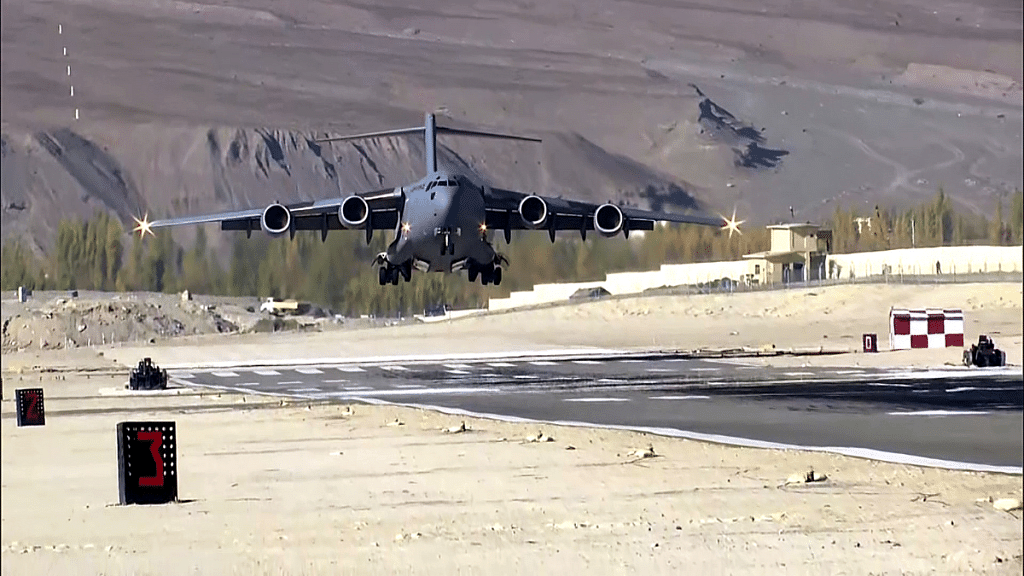SOURCE: AFI


In a landmark achievement for the Indian Air Force (IAF), a massive C-17 Globemaster-III aircraft successfully landed at the high-altitude Kargil airfield near the Line of Control (LoC) with Pakistan on Wednesday morning. This “trial run” marks the first time the gigantic four-engine transporter has touched down at the strategically vital airstrip, significantly enhancing the IAF’s ability to airlift troops and heavy equipment to forward areas along India’s northern frontier.
The C-17, which took off from its home base at Hindon Air Force Station on the outskirts of Delhi, navigated challenging terrain to land at the Kargil airstrip. Situated at an altitude of over 9,700 feet and surrounded by towering mountains on all sides, the airfield presents a unique set of operational difficulties, including thin air and limited maneuvering space. The successful landing underscores the IAF’s growing proficiency in operating heavy-lift aircraft in some of the most demanding environments.
Wednesday’s operation is seen as a precursor to more ambitious plans. “The next step will be to conduct a night landing by a C-17 at Kargil,” an IAF official said. The ability to operate at night would further bolster the force’s tactical flexibility, enabling rapid deployment of resources under the cover of darkness—a critical advantage in a region marked by heightened military sensitivity due to its proximity to the LoC.
The C-17 Globemaster-III, manufactured by Boeing, is one of the IAF’s most advanced strategic airlifters, capable of carrying a payload of up to 70 tonnes under normal conditions. However, at Kargil’s high altitude, where lower oxygen levels reduce engine efficiency and lift capacity, the aircraft’s payload is limited to approximately 35 tonnes. Even with this constraint, the C-17 offers a quantum leap in load-carrying capacity compared to other aircraft previously deployed at the airstrip.
The IAF has prior experience operating at Kargil with smaller aircraft. In January 2024, a C-130J Super Hercules, another versatile transporter in the IAF fleet, successfully conducted a night landing at the same airfield. While the C-130J can airlift around 20 tonnes of cargo, the C-17’s capacity at Kargil—approximately 35 tonnes—represents a fourfold increase. This enhanced capability allows the IAF to deliver heavier equipment, additional personnel, or critical supplies in a single sortie, significantly improving operational efficiency in the region.
“The C-17 increases the load-carrying capacity by around four times,” the official noted, highlighting the aircraft’s role in strengthening India’s military posture along the LoC. The Kargil airfield, originally constructed during the 1999 Kargil War to support logistics, has since been upgraded to accommodate larger aircraft, reflecting the IAF’s long-term strategy to fortify its presence in forward areas.
The successful landing of the C-17 at Kargil comes at a time when India is intensifying efforts to enhance its infrastructure and operational readiness along its borders. The airfield’s proximity to the LoC makes it a linchpin for rapid troop deployment, emergency evacuations, and the transport of heavy machinery or artillery to support ground forces. The ability to operate a heavy-lift aircraft like the C-17 in such a challenging environment demonstrates the IAF’s technical expertise and its commitment to maintaining a robust deterrent in the region.
NOTE: AFI is a proud outsourced content creator partner of IDRW.ORG. All content created by AFI is the sole property of AFI and is protected by copyright. AFI takes copyright infringement seriously and will pursue all legal options available to protect its content.